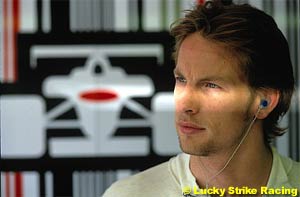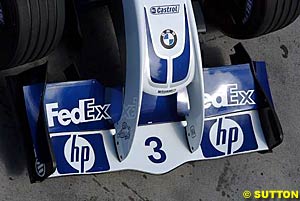Atlas F1 Magazine Writer
Fresh from the Formula One paddock
That Jenson Button was defecting may have come as a surprise to BAR-Honda, but, really, all the team had to do was pay attention during his Media Conference in Cape Town, South Africa a week before the Williams bombshell to know that all was not well.
The driver, third behind Michael Schumacher and Rubens Barrichello in this year's title chase with 61 points, was asked by a local journalist - with no connections to F1 – what his contractual situation was with his present team.
Yet, whilst on rally business in Finland for that country's 'Gravel Grand Prix', David Richards, boss of BAR (and Prodrive founder and shareholder, and chairman of ISC, rallying's commercial rights organisation) stated emphatically to the Grapevine that "the option was taken up, in writing, on 21 July, a copy was given to Jenson's management team on 25 July (German Grand Prix Sunday), and a copy hand-delivered to the management company in London on 27 July (the day Jenson and manager John Byfield arrived in Cape Town) where it was signed for. Immediately thereafter a copy of the contract was lodged with the Contract Recognition Board in Geneva."
Assuming all that to be true, and, in true F1 fashion, ASSUME all too often boils down to (make an) ASS of U and ME, then why did alarm bells not ring loudly all over England? Surely some BAR body present in that packed room must have picked up on his comments and reported them to base. Sure, Button did his bit in Cape Town which is 6,000 miles from base, but, all day, mobile phone calls bounced back and forth between Brackley and the tip of Africa.
Which brings us neatly to the next point – just why would JB wish to leave BAR for a team currently lying almost 30 points adrift of BAR, and whose best-placed driver has scored but 33? Various factions have indicated that discord originally broke out when Jenson's points' money structure was changed early in the season; others that no change was effected, but that the outstandings have not been settled. But, both theories have various holes in them: early in the season nobody had a true inkling just how successful would be Geoff Willis' 006, so just why would bonuses have been so contentious back then? Equally, at that point of the season folk 'in the know' were prophesying victories for McLaren and Williams, the downfall of Ferrari through conservatism, all whilst accusing BAR of testing 'light'...
Plus, Honda's most powerful had blown regularly in testing and BAR had switched to Michelins, so, surely, any talk of points' money with JB would have been, at best, premature, and, at worst, speculative. What is known, though, is that BAR did downscale points' bonuses to team members: where, two years ago, £100 was paid to each employee per point scored by the team, this was cut by half in 2003 and by half again this year. So, where in 2002 a technician trousered £700 from seven points and £1300 (26 points) last season the next year, this year he has already pocketed £1525 with a third of the season still to go. So, what at first sight seemed unfair has turned out to be eminently just. Now, would a team boss treat his star driver any differently, even if the suggested fee of $100,000/point, or even $50,000, has been reduced to, say, $10,000?
ASSUMING, though, this to be the T-bone of contention, it stands to reason that Jense, on a reputed $4m per season, is hardly out of pocket this year, or was ever likely to be at BAR over the following two, particularly given the continued creativity Willis' team (and the impact of Honda's implied commitment for the next three years – publicly announced, please note, on 23 July at Hockenheim) will bring to bear on the Brackley-based outfit. And, why should Richards welsh on paying agreed bonuses? He is, after all, a contractual manager spending not his own money, but, rather conveniently, British American Tobacco's, which company, one would have thought, should be only to pleased to pay on results after six fallow years extending back to its team's founding.
And, where, on present evidence, should an aspirant Grand Prix winner (make that 'champion') really be settling down for the long haul? At a BAR-Honda dedicating their mega-mountains of corporate cash and increasingly reliable and powerful engines in his direction, or at a Williams, where he had been who have (present) nose out of joint, engines no longer believed to be from the top drawer, and a management style which breeds conflict and insecurity as proven by his, Button's, dumping in 2000 to make way for Juan Pablo Montoya? And, forget not, Michelin's choices remain the same either way.
But, the last two paragraphs provide two reasons for the defection: $4m and Honda's implied commitment. Button's deal with BAR was struck during the French Grand Prix in 2002, immediately after his then-team boss Flavio Briatore gave Button a sack to drag around for the remainder of the season. Jarno Trulli and Fernando Alonso – both personally managed by the Italian – would carry Renault's future hopes, announced Briatore, and a battered and bruised Jenson was all at sea. Richards threw him a lifeline.
Since then, team and driver have come a long way, and Button's worth must be triple the initial fee – and doubts remain as to whether Byfield inserted a sufficiently large escalator. And, to a ten-percenter, that hurts. Richards, who had taken the gamble upon Button, would not bend, so, sources say, an 'out' of BAR was sought by Button/Byfield, who had inserted demands in the contract that the team be powered by a manufacturer engine.
Honda is thought to have provided the key on either 22 or 23 July. Possibly the Japanese company, which, forget not, abruptly terminated its relationship with Williams in 1987 after their team boss suffered paralysis in the wake of a car crash in 1986, had not signed its three-year extension by 21 July (although the intent was there, and the deal was certainly signed by 23 July); possibly its 'get-out of F1' clause – admitted to during the announcement following an astute question by a British journalist – should the formula fail to be the technical pinnacle of motor sport, enabled Byfield to call Grove seeking a lucrative berth for Button on the basis that BAR had not correctly taken up the option which expired on 31 July.
And, Sir Frank, no doubt recalling his treatment at Honda's hands, reached for his pen. He had, after all, earlier this year pronounced his ideal 2005 pairing to be Webber and Button, and here was his wish delivered on a silver platter, all whilst providing a golden opportunity of getting even with the manufacturer for whom he secured three titles in 1986-7 despite notice of termination.
Of course, Button is said to be 'hurt' by suggestions that the move was motivated by greed, but what else could have led to it? Equally, somewhere, despite protestations that Button/Byfield had approved all applicable clauses in BAR's Honda contract, tardiness must have entered into matters, for, suddenly, a contract believed to be utterly watertight sprang enough leaks to drive a BAR and Williams through. Side-by-side, at that.
There are four sides to this story: BAR-Honda's, Williams', Button/Byfield's, and the truth. The CRB, established during 1992 in the wake of, but not as a direct result of, Michael Schumacher's defection to Briatore's Benetton the previous year, will have to rule soon as to who owns the only valid 2005 contract, but cannot do so until Williams has lodged their deal with Button.
Had BAR taken heed of Jenson's reply to that South African journalist on 27 July, it would have had four days in which to rectify any shortcomings. Now it could wait up to four months for a definitive ruling.
Button's defection was not the only news put out by Williams this week past. On Saturday, another, less controversial, announcement was made: the team were dumping the 'tusk-nose' on the FW26 in favour of a more effective (and, hopefully, more elegant) schnozzle.
Rory Byrne had his first sighting of the 'Walrus' on Imola Sunday, and Ferrari's Chief Designer prescient comments came back when hearing of Williams' decision. The FW26, in the hands of Juan Pablo Montoya, had qualified third to line up behind Jenson Button on pole and the Ferrari of Michael Schumacher alongside the BAR-Honda.
When asked exactly what he meant, he pointed to the open-mouth of the car. "They're trying to funnel as much clean air as possible through the front, and onto the lip directly under the cockpit," explained Byrne patiently during the first of two scheduled visits to a Grand Prix this year – the second being Monza. But, then pointing to the twin-keel layout, he made wing-flapping gestures with his arms. "The forces trying to force open those keels in anything other than a straight line must be tremendous, and under braking it is far worse."
So, based upon Byrne's analysis - and total trust should be placed in the man responsible for the cars which have delivered all but three of Michael Schumacher's 81 career wins - the FW26 should have proven fast and stable in a straight line, but darty under high-speed braking, and, crucially, more unstable whilst braking during turn-in. And, a driver who stood-in for Ralf Schumacher recently, admitted to these shortcomings at Hockenheim.
Continuing his in loco lecture, Byrne walked forward one grid row to 'his' F2004 and pointed to its 'knife-blade' single keel mounting, then holding his arms wide, brought them down in an equal motion. "See, all the forces act on one centre point, so you don't get rolling," which he illustrated by lifting and raising his shoulders in opposite directions as he eyed the smoothest bottom in F1.
Sources advise that Williams have not presented a revised tub for crash-testing, so it seems the twin-keel layout, with its inherent disadvantages, has been retained. Then, a non-tusk nose will not bring with it the advantage of a rush of clean air, so downforce will be compromised. Finally, in view of the test ban, the new nose has hardly, if at all, been track-tested. At this stage of the season, with third-placed BAR-Honda edging ahead and fifth-placed McLaren catching fast, can Williams really afford to risk racing a fundamentally untested design, particularly at the Hungaroring, which, more than most, rewards downforce and stability under braking?
Of course, the team could argue that they tested their revisions on rigs and in either of the two wind tunnels at their disposal, but they said that about 'tusk-nose', too...

 "It is a two-year contract which expires at the end of this year, with an option for another two years which has not yet been taken up. There are still a few points to discuss." This, please note, was said in Rhodes House - previously the residence of the governor of the Cape; now a very upmarket see-and-be-seen venue – on 27 July. Then, in reply to an unrelated question from another scribe, Jenson hinted that Mark Webber – to be his Williams teammate if Sir Frank's deal is judged to be bullet-proof - would be his biggest challenger in future. In retrospect, did Jenson know back then that he and Webber would receive identical treatment in identical cars?
"It is a two-year contract which expires at the end of this year, with an option for another two years which has not yet been taken up. There are still a few points to discuss." This, please note, was said in Rhodes House - previously the residence of the governor of the Cape; now a very upmarket see-and-be-seen venue – on 27 July. Then, in reply to an unrelated question from another scribe, Jenson hinted that Mark Webber – to be his Williams teammate if Sir Frank's deal is judged to be bullet-proof - would be his biggest challenger in future. In retrospect, did Jenson know back then that he and Webber would receive identical treatment in identical cars?

 "I can see what they're (Williams) trying to achieve," said the South African-born industrial chemist who won glider world championships as a teenager, "but they must be paying a massive price in rigidity."
"I can see what they're (Williams) trying to achieve," said the South African-born industrial chemist who won glider world championships as a teenager, "but they must be paying a massive price in rigidity."
|
Contact the Author Contact the Editor |
Please Contact Us for permission to republish this or any other material from Atlas F1.
|
Volume 10, Issue 32
Articles
The Piranhas Bite Again
Technical Analysis: The FIA Proposals
Man in the Middle
Every Other Sunday
2004 Hungarian GP Preview
2004 Hungarian GP Preview
Hungarian GP Facts & Stats
Columns
The F1 Trivia Quiz
Rear View Mirror
Bookworm Critique
On the Road
Elsewhere in Racing
The Weekly Grapevine
> Homepage |
